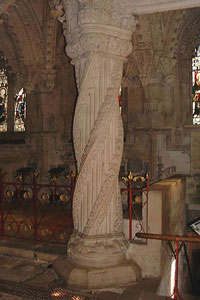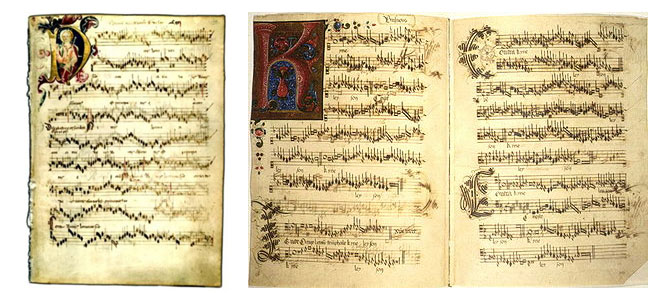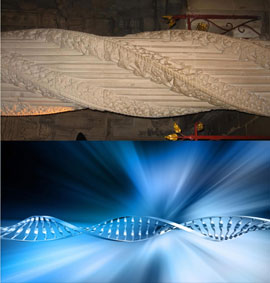DNA and the Apprentice Pillar
By Stuart Mitchell
‘If thoust can comprehend these things, thoust know enough’ – William St Clair
In Rosslyn Chapel stands one of the most striking and exquisitely crafted stone pillars ever imagined. It is called sometimes The Prince’s Pillar or alternatively The Apprentice Pillar.
 The ‘Apprentice Pillar’, or ‘Prentice Pillar’, gets its name from a legend dating from in the 18th century, which involves a master mason in charge of the stonework in the chapel and his young apprentice. According to the legend, the master mason does not believe that the apprentice can perform the complicated task of carving the column, without seeing the original which formed the inspiration for the design. The master mason travels to see the original himself, but upon his return is enraged to find that the upstart apprentice has completed the column anyway. In a fit of jealous anger the mason takes up his mallet and strikes the apprentice on the head, killing him. As punishment for his crime, the master mason’s face is carved into the opposite corner to forever gaze upon his apprentice’s pillar.
The ‘Apprentice Pillar’, or ‘Prentice Pillar’, gets its name from a legend dating from in the 18th century, which involves a master mason in charge of the stonework in the chapel and his young apprentice. According to the legend, the master mason does not believe that the apprentice can perform the complicated task of carving the column, without seeing the original which formed the inspiration for the design. The master mason travels to see the original himself, but upon his return is enraged to find that the upstart apprentice has completed the column anyway. In a fit of jealous anger the mason takes up his mallet and strikes the apprentice on the head, killing him. As punishment for his crime, the master mason’s face is carved into the opposite corner to forever gaze upon his apprentice’s pillar.
Since the very first moment I began my research at Rosslyn regarding the cubes, I was always certain that whoever decided to contain a musical piece in code, would leave a ‘cipher’, ‘primer’ or ‘key’ which contained a clue to the discovery of the notes. It is almost as if he knew someday someone would pay close inspection to the detail on this particular carved, angel and thereby eliminate it as an actual instrument, thus seeing the musical truth beyond the decoy. Like all good primers, a large portion of the work has been staring everyone in the face for centuries and by directing this central angel on The Apprentice Pillar to point at the leading notes, we can now hear the true music that the designer intended.
The Apprentice Pillar was always ‘Key’ to the elements involved in the decoding process, simply because the elaboration and decorative style of the pillar looks like a starting point. In the same way composers of the time would begin with an elaborately drawn calligraphy of a Clef for the beginning of the music.

The design of the pillar came to the ‘Apprentice’ in a Dream according to legend and its design cannot be discounted as resembling the helix of DNA. Many people have remarked upon the similarity to the extent that perhaps the Apprentice or the creators of Rosslyn were aware of this helix shape being embedded within nature’s principals. We are not saying they ‘knew about DNA’, but that the helix structure is a fundamental geometric principal of the laws and design of nature. Nature employs the helix structure for its functionality and beauty.
 It was these moments of realization that led me to involve myself in the possibility that DNA and music are entwined in a cycle of geometry that expresses perfection in proportion through form.
It was these moments of realization that led me to involve myself in the possibility that DNA and music are entwined in a cycle of geometry that expresses perfection in proportion through form.
The music we discovered after these realizations is close to the same simplicity with which the designers and composers of Rosslyn have portrayed in their cymatic musical score. William St Clair and Sir Gilbert Haye opened the doors to a world of nature that is dominated by sound and vibration. No wonder they used Cymatics to express their music. God was singing thru them, and singing his music using the fundamental principals of sound, geometry and structure.
All of nature is an expression of form, and that form and that form, we now know, is constructed by sound/vibration on every level of existence.
The Apprentice Pillar proves that from our genetic code to the level of Spiral galaxy formation, nature employs this shape as an expression of the ‘perfect building blocks of life’ and the un-wrapping of code and information that is compacted into a structure inherent in the geometry of reality.
Content courtesy of Stuart Mitchell
Copyright (c) 2011. All Rights Reserved.
https://www.stuart-mitchell.com/









